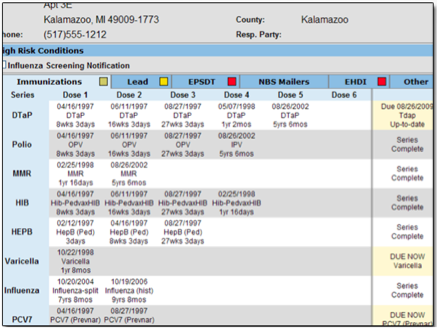Last week Dr. Dugan Maddux had us all singing the 12 Days of Christmas with a Health IT twist. The holidays can also have many of us singing the blues, as the season coincides with the middle of the annual flu season. The CDC estimates that on average 200,000 patients will be hospitalized every flu season due to a flu-related illness, and unfortunately many of those patients will not survive. The most important thing a person can do to reduce that risk is to get a flu shot. As simple as that sounds, administering the flu vaccine can be a challenge, especially if you are a provider participating in Meaningful Use.
A little background
Stage 1 of Meaningful Use introduced the immunization measure as part of its menu set. Providers in Stage 1 can choose between the immunization or the syndromic surveillance public health measures as one of their five menu set objectives. If the immunization measure is selected, providers have to send one immunization test message to their Immunization Information System (IIS). If the test submission is successful, providers should institute regular reporting with their IIS.
In Stage 2, the immunization objective moved from a menu set objective to a core objective. It also requires successful ongoing submission of immunization data from the provider’s EHR to an IIS throughout the reporting period.
What is an IIS?
An IIS is a confidential, population-based, computerized system that records all vaccination doses administered by participating providers to people within a given area. It provides the ability to create a comprehensive immunization record for a patient by consolidating vaccinations administered by different providers into one electronic record. These systems can also provide clinical decision support, to look at a patient’s immunization history and generate a forecast or recommendation of vaccines to administer based upon the Advisory Committee on Immunization Practice (ACIP) recommendations for vaccination.
Below is a screenshot of a patient’s record within an IIS.

The ONC listed the following benefits of an IIS:
- Consolidate immunization histories for the patient.
- Provide access to complete immunization history at the point of care.
- Eliminate a provider’s need to locate and transfer paper immunization records for new patients and ensure patients receive recommended immunizations on schedule.
- Improve office efficiency by reducing hours often spent gathering and consolidating paper immunization records.
- Minimize the likelihood of immunization record errors from potential data entry issues by submitting the record electronically to an IIS.
- Enable public health departments to identify both children and adults at risk in the event of a disease outbreak.
- Provide targeted interventions to increase coverage rates and protect more children from disease in areas with low vaccination rates.
While the list above sounds like a great tool for a primary care provider, it may not be as applicable to a nephrologist who only wants to track Hep B, Pneumococcal, and the flu shot.
Succeeding with the immunization measure
As noted in the beginning of this post, the immunization measure isn’t a quick, easy-button measure. Consider these 5 steps to success:
- Determine if you are excluded from this objective. If you do not give any immunizations during your reporting period, you can claim an exclusion from this objective. If you only administer the flu shot in your office and you are in a 90-day reporting period that falls outside of the flu season, you are also excluded. However, if your reporting period falls during the season in which you give the flu shot, you are required to report this measure. Note that if your IIS isn’t capable of receiving immunization data in the standard defined by the final rule you may be eligible for an exclusion.
- There is no magic number. Even if you only administer a handful of immunizations during a reporting period, you are eligible to report this measure. I spoke with a nephrologist earlier this year that said he only gave a few flu shots during the reporting period and asked if he really needed to sign up with a PHA. My advice was yes, as there isn’t a minimum number of immunizations that a provider must administer in order to be eligible for this measure. Therefore, it is always best to follow the measure exactly as it is stated to protect yourself from a pre- or post-payment audit.
- Ask your Certified EHR if they can transport immunization data to an IIS. The final rule didn’t require that EHRs have the ability to transport immunization data from the EHR to your state’s IIS. The final rule only required that the EHR was able to produce a compliant immunization message using the HL7 2.5.1 standard. Therefore providers may have to determine how to transfer data themselves. Your EHR might already have a service in place to do this for you; if not, there are companies that offer a transport solution (normally for a cost).
- Sign up with your IIS. Each provider that selects the immunization measure must sign up with his/her IIS within the first 60 days of their reporting period. Don’t wait until the last few days of the reporting period to do this step!
- Keep a paper trail. Collect any documentation or emails that indicate when you signed up for the IIS, when successful transmissions occurred, and any communications between you and the IIS. If you are claiming an exclusion, be prepared with documentation that you are excluded from this measure.
After reading this post do you feel like retiring your syringes in the New Year or will you give the IIS a shot?
 Diana Strubler, Senior Product Analyst, Health IT Standards, joined Acumen in 2010 as an EHR trainer then quickly moved into the role of certification and health IT standards subject matter expert. She has successfully led Acumen through three certifications while also guiding our company and customers through the world of Meaningful Use, ICD-10 and PQRS.
Diana Strubler, Senior Product Analyst, Health IT Standards, joined Acumen in 2010 as an EHR trainer then quickly moved into the role of certification and health IT standards subject matter expert. She has successfully led Acumen through three certifications while also guiding our company and customers through the world of Meaningful Use, ICD-10 and PQRS.




Leave a Reply